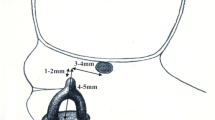Abstract
Purpose of Review
Ossicular erosion is a well-known complication of chronic ear disease, particularly when associated with cholesteatoma. Discontinuity of the ossicular chain can result in varying degrees of conductive hearing loss. Surgical correction and rehabilitation through ossiculoplasty has long been described as a successful means of hearing rehabilitation. Since its original description, numerous advancements have been made, particularly in the sector of prosthesis design and development.
Recent Findings
Since the original ossicular chain reconstruction (OCR) was first described in 1952, various allografts, autografts, and homografts have all been utilized as ossicular prostheses. Since no one graft material was deemed superior to the others, grafts from each subtype were developed and implemented contemporaneously. While homografts lost popularity in the 1980s following concerns of disease transmission, they continue to have concentrated areas of use outside of the USA and Europe. Alternatively, autograft and allografts remain popular interposition mediums. Each has continued to evolve since their first description.
Summary
Ossiculoplasty has evolved dramatically over the past 70 years. Marked advances in ossicular prosthesis design as well as improvements in bio-inert materials have heralded in new possibilities in the reconstruction and rehabilitation of conductive hearing loss.

Similar content being viewed by others
References
Zöllner F. Principles of plastic surgery of the sound conduction apparatus. J Laryngol Otol. 1955;69:637–52.
Wullstein H. Theory and practice of tympanotoplasty. Laryngoscope. 1956;66:1076–93.
House HP. Polyethylene in middle ear surgery. Arch Otolaryngol. 1960;71(6):926–31.
Shambaugh GE. Developmental anomalies of the sound conduction apparatus and their surgical correction. Ann Otol Rhinol Laryngol. 1952;61(3):873–87.
Withers BT, Hatfield SE, Richmond RW. Drum and middle ear grafts in cats. Laryngoscope. 1963;73:1022–43.
Janeke JB, Shea JJ. Self-stabilizing proplast total ossicular replacement prosthesis in tympnoplasty. Laryngoscope. 1975;85(9):1550–6.
Shea JJ. Plastipore total ossicular replacement prosthesis. Laryngoscope. 1976;86(2):239–40.
Portmann M, Bebear JP, Bagot d’Arc M, et al. Ossicular prosthesis in functional surgery of the ear (proplast, plastipore and ceramics). Clinical audiometric results apropos of 214 cases. An Otorrinolaringol Ibero Am. 1984;11(2):127–34.
Grote J. Tympanoplasty with calcium phosphate. Arch Otolaryngol. 1984;110:197–9.
Grote JJ, Kuypers W. Use of biomaterials in reconstructive middle ear surgery. In: Rubin LR, editor. Biomaterials in reconstructive surgery. St Louis: CV Mosby Co; 1983. p. 987–95.
Palva T, Palva A, Karja J. Results with 2- or 3-legged wire columellization in chronic ear surgery. Ann Otol. 1971;80:760–5.
Dalchow CV, Grun D, Stupp HF. Reconstruction of the ossicular chain with titanium implants. Otolaryngol Head Neck Surg. 2001;125:628–30.
Hall A, Rytzner C. Vitality of auto-transplanted ossicles. Acta Otolaryngol Suppl. 1960;158(52):334–40.
Bell HL. A technique of tympanoplasty (tympanomalleolar stapediopexy). Laryngoscope. 1958;68(5):883–7.
Hough JVD. Incudostapedial joint separation: etiology, treatment and significance. Laryngoscope. 1959;69(6):644–64.
Pulec JL, Sheehy JJ. Symposium on tympanoplasty: ossicular chain reconstruction. Laryngoscope. 1973;83(4):448–65.
Millls RP, Phill M. The use of cortical bone grafts in ossiculoplasty I: surgical techniches and hearing results. J Laryngol Otol. 1993;107(8):686–9.
House WF, Patterson ME, Linthicum FH Jr. Incus homograft in chronic ear surgery. Arch Otolaryngol. 1966;84(2):148–53.
Wehrs RE. Results of homografts in middle ear surgery. Laryngoscope. 1978;88(5):808–15.
Jansen C. Cartilage – tympanoplasty. Laryngoscope. 1963;73:1288–301.
Iwanaga M, Mori H, Yamamoto E, Toda Y, Fukumoto M. The fate of homologous nasal septal cartilages in tympanoplasty. Acta Otolaryngol. 1986;101(3–4):306–13.
Kerr AG, Byrne JE, Smyth GD. Cartilage homograft in the middle ear: a long term histologic study. J Laryngol Otol. 1973;87:1193–9.
Glascock ME, Jackson CG, Knox GW. Can acquired immunodeficiency syndrome and Cretzfeld-Jackob disease be transmitted via otologic homografts. Otolaryngol Head Neck Surg. 1988;114(11):1252–5.
Lubbe D, Fagan JJ. Revisiting the risks involved in using homograft ossicles in otologic surgery. J Laryngol Otol. 2008;122(2):111–5.
Author information
Authors and Affiliations
Corresponding author
Ethics declarations
Conflict of Interest
David D. Walker declares that he has no conflict of interest.
Seilesh C. Babu reports personal fees from Acclarent, grants from Oticon Medical, and grants from Cochlear Corporation.
Human and Animal Rights and Informed Consent
This article does not contain any studies with human or animal subjects performed by any of the authors.
Additional information
Publisher’s Note
Springer Nature remains neutral with regard to jurisdictional claims in published maps and institutional affiliations.
This article is part of the Topical Collection on Ossicular Chain Reconstruction
Rights and permissions
About this article
Cite this article
Walker, D.D., Babu, S.C. History of Ossicular Chain Reconstruction. Curr Otorhinolaryngol Rep 8, 61–64 (2020). https://doi.org/10.1007/s40136-020-00259-w
Published:
Issue Date:
DOI: https://doi.org/10.1007/s40136-020-00259-w




